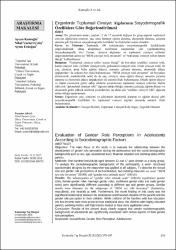Ergenlerde Toplumsal Cinsiyet Algılarının Sosyodemografik Özelliklere Göre Değerlendirilmesi
Özet
Amaç: Bu çalışmanın amacı, yaşları 12 ile 17 arasında değişen bir grup ergenin toplumsal
cinsiyet algılarının cinsiyet, yaş, anne babanın eğitim durumu, ekonomik durumu, çalışma
durumu gibi bir takım sosyodemografik özellikler ile ilişkilerini analiz etmektir.
Gereç ve Yöntem: Toplamda 100 katılımcının sosyodemografik özelliklerini
değerlendirmek adına araştırmacı tarafından oluşturulan yarı yapılandırılmış
Sosyodemografik Veri Formu, cinsiyet algılarını ve toplumsal cinsiyet rollerini
değerlendirmek adına ise ―BEM cinsiyet rolü envanteri‖ ve ―toplumsal cinsiyet rolleri tutum
ölçeği‖ kullanılmıştır.
Bulgular: ―Toplumsal cinsiyet rolleri tutum ölçeği‖ alt boyutları (eşitlikçi cinsiyet rolü,
kadın cinsiyet rolü, evlilikte cinsiyet rolü, geleneksel cinsiyet rolü, erkek cinsiyet rolü) ile
yaş, cinsiyet, anne baba eğitim düzeyi, annenin çalışma durumu, ekonomik düzey
değişkenleri ile anlamlı bir ilişki bulunmuştur. ―BEM cinsiyet rolü envanteri‖ alt boyutları
(feminenlik, maskülenlik, nötr) ile de yaş, cinsiyet, anne eğitim düzeyi, annenin çalışma
durumu ve ekonomik düzey değişkenleri ile anlamlı ilişki bulunmuştur. Düşük eğitim düzeyi
ve düşük ekonomik gelire sahip ailelerin çocuklarının toplumsal cinsiyet rollerine ilişkin
daha çok ―geleneksel cinsiyet rolü‖ algısına sahip olduğu; annenin çalıştığı, eğitim düzeyi ve
ekonomik geliri yüksek ailelerin çocuklarının ise daha çok ―eşitlikçi cinsiyet rolü‖ algısına
sahip olduğu saptanmıştır.
Sonuç: Ergenlerin yaşı, cinsiyeti ve ailelerinin ekonomik durumu ve eğitim düzeyi gibi
sosyodemografik özellikleri ile toplumsal cinsiyet algıları arasında anlamlı ilişki
bulunmuştur. Objective: The main focus of the study is to evaluate the relationship between the
development of gender role perception during the adolescence and the social demographic
backgrounds such as sex; age; educational level, financial situation and working status of the
parents.
Methods: One hundred individuals aged between 12 and 17 were chosen as a study group.
To analyze the sociodemographic backgrounds of the participants, a semi- structured
questionnaire designed by the researcher was applied to all subjects. To describe the sexual
role and gender role perceptions of each individual, two existing measures are used: ―BEM
sex role inventory‖ (BSRI) and ―gender roles attitude scale‖ (GRAS).
Results: The subcategories of ―gender roles attitude scale‖ (GRAS) (egalitarian gender
roles, female gender roles, marriage gender roles, traditional gender roles and male gender
roles) were significantly different according to different age and gender groups. Similar
results were obtained for the subgroups of ―BEM sex role inventory‖ (femininity,
masculinity, and neutral) as well. Furthermore, the novel finding of this study was the
significant relationship between the educational and financial situation of the parents and the
gender role perception in their children. While children of the families with low education
and low income were more prone to have traditional view; the children with highly educated
parents, working mother and high income tended to have more egalitarian view.
Conclusion: Results of the present study clearly suggest that certain sociodemographic
backgrounds of adolescents are significantly associated with certain aspects of their gender
role perceptions.

















